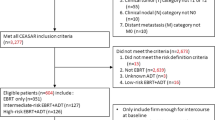Abstract
Background
We aimed to evaluate long-term erectile function following prostate brachytherapy, based on patient characteristics and treatment factors.
Methods
Between 2003 and 2006, 665 men with localized prostate cancer were treated with 125I permanent seed implantation. None was given adjuvant hormone therapy. Erectile function was assessed before treatment, and at 6 months, 1, 2, 3, 4 and 5 years after implantation using the Mount Sinai Erectile Function Score (MSEFS) of 0–3 (0 = no erections, 1 = erections insufficient for intercourse, 2 = suboptimal erections but sufficient for intercourse, 3 = normal erectile function). Potency was defined as score 2 or 3, and 382 men were potent before treatment. Univariate and multivariate analyses were performed on the data from these 382 patients to identify variables associated with potency preservation.
Results
In patients who were potent before treatment, the actuarial potency preservation rate fell to 46.2 % at 6 months after brachytherapy, and then slowly recovered reaching 52.0 % at 5 years after brachytherapy. In multivariate logistic regression analysis, patient age (p = 0.04) and pre-treatment MSEFS (p < 0.001) were predictors of 5-year potency preservation. Neoadjuvant hormone therapy affected potency preservation only at 6 months after brachytherapy.
Conclusions
Patient age at implantation and pre-treatment erectile function are predictive factors for the development of erectile dysfunction following prostate brachytherapy.




Similar content being viewed by others
References
Kupelian PA, Potters L, Khuntia D et al (2004) Radical prostatectomy, external beam radiotherapy < 72 Gy, external beam radiotherapy ≥72 Gy, permanent seed implantation, or combined seeds/external beam radiotherapy for stage T1–T2 prostate cancer. Int J Radiat Oncol Biol Phys 58:25–33
Peschel RE, Colberg JW (2003) Surgery, brachytherapy, and external-beam radiotherapy for early prostate cancer. Lancet Oncol 4:233–241
Sanda MG, Dunn RL, Michalski J et al (2008) Quality of life and satisfaction with outcome among prostate-cancer survivors. N Engl J Med 358:1250–1261
Robinson JW, Moritz S, Fung T (2002) Meta-analysis of rates of erectile function after treatment of localized prostate carcinoma. Int J Radiat Oncol Biol Phys 54:1063–1068
Crook JM, Gomez-Iturriaga A, Wallace K et al (2011) Comparison of health-related quality of life 5 years after SPIRIT: surgical prostatectomy versus interstitial radiation intervention trial. J Clin Oncol 29:362–368
Alemozaffar M, Regan MM, Cooperberg MR et al (2011) Prediction of erectile function following treatment for prostate cancer. JAMA 306:1205–1214
Zelefsky MJ, Hollister T, Raben A et al (2000) Five-year biochemical outcome and toxicity with transperineal CT-planned permanent I-125 prostate implantation for patients with localized prostate cancer. Int J Radiat Oncol Biol Phys 47:1261–1266
Stone NN, Stock RG (2007) Long-term urinary, sexual, and rectal morbidity in patients treated with iodine-125 prostate brachytherapy followed up for a minimum of 5 years. Urology 69:338–342
Merrick GS, Butler WM, Wallner KE et al (2005) Erectile function after prostate brachytherapy. Int J Radiat Oncol Biol Phys 62:437–447
Cancer Registration Committee of the Japanese Urological A (2005) Clinicopathological statistics on registered prostate cancer patients in Japan: 2000 report from the Japanese Urological Association. Int J Urol 12:46–61
Ohashi T, Yorozu A, Toya K et al (2005) Acute urinary morbidity following I-125 prostate brachytherapy. Int J Clin Oncol 10:262–268
Ohashi T, Yorozu A, Toya K et al (2007) Rectal morbidity following I-125 prostate brachytherapy in relation to dosimetry. Jpn J Clin Oncol 37:121–126
Yoshida K, Ohashi T, Yorozu A et al (2013) Comparison of preplanning and intraoperative planning for I-125 prostate brachytherapy. Jpn J Clin Oncol 43:383–389
Stock RG, Stone NN, Cesaretti JA et al (2006) Biologically effective dose values for prostate brachytherapy: effects on PSA failure and posttreatment biopsy results. Int J Radiat Oncol Biol Phys 64:527–533
Stock RG, Kao J, Stone NN (2001) Penile erectile function after permanent radioactive seed implantation for treatment of prostate cancer. J Urol 165:436–439
Zagar TM, Stock RG, Cesaretti JA et al (2007) Assessment of postbrachytherapy sexual function: a comparison of the IIEF-5 and the MSEFS. Brachytherapy 6:26–33
Taira AV, Merrick GS, Galbreath RW et al (2009) Erectile function durability following permanent prostate brachytherapy. Int J Radiat Oncol Biol Phys 75:639–648
Potters L, Torre T, Fearn PA et al (2001) Potency after permanent prostate brachytherapy for localized prostate cancer. Int J Radiat Oncol Biol Phys 50:1235–1242
Snyder KM, Stock RG, Buckstein M et al (2012) Long-term potency preservation following brachytherapy for prostate cancer. BJU Int 110:221–225
Kollmeier MA, Fidaleo A, Pei X et al (2013) Favourable long-term outcomes with brachytherapy-based regimens in men ≤60 years with clinically localized prostate cancer. BJU Int 111:1231–1236
Zelefsky MJ, McKee AB, Lee H et al (1999) Efficacy of oral sildenafil in patients with erectile dysfunction after radiotherapy for carcinoma of the prostate. Urology 53:775–778
Bannowsky A, Schulze H, van der Horst C et al (2008) Recovery of erectile function after nerve-sparing radical prostatectomy: improvement with nightly low-dose sildenafil. BJU Int 101:1279–1283
Pahlajani G, Raina R, Jones JS et al (2010) Early intervention with phosphodiesterase-5 inhibitors after prostate brachytherapy improves subsequent erectile function. BJU Int 106:1524–1527
Acknowledgments
The authors are grateful to Ms. Kazuko Ogawa at Keio University School of Medicine for her support and assistance.
Conflict of interest
The authors declare that they have no conflict of interest.
Author information
Authors and Affiliations
Corresponding author
About this article
Cite this article
Nishimura, S., Yorozu, A., Ohashi, T. et al. Five-year potency preservation after iodine-125 prostate brachytherapy. Int J Clin Oncol 19, 940–945 (2014). https://doi.org/10.1007/s10147-013-0632-8
Received:
Accepted:
Published:
Issue Date:
DOI: https://doi.org/10.1007/s10147-013-0632-8




